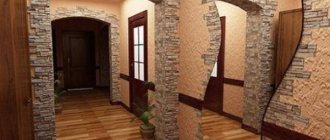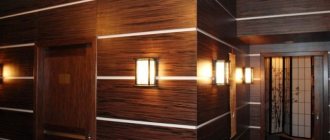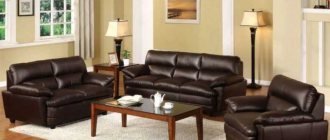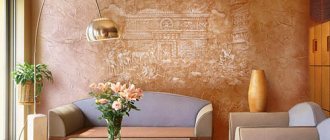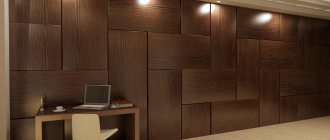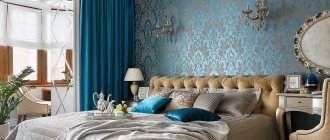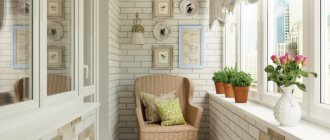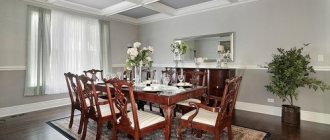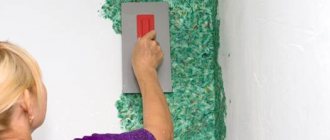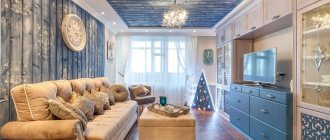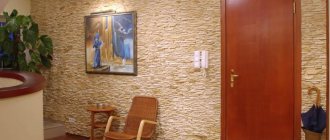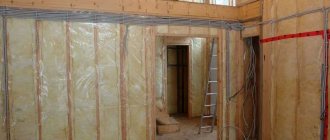What are fabric wall coverings made from?
Content
Textile wallpaper consists of two layers - the main and front surfaces, glued together. The first is paper or non-woven fabric, on which cotton, linen, felt, velor, jute, silk threads and fabrics are applied.
After prolonged drying with infrared rays, the finished fabric wallpaper sheets are rolled into rolls. It has been noticed that even with the same equipment settings, the next batch of products may differ from the previous one in shade.
- Fabric wallpaper: photo of coating
Finishes such as fabric wallpaper for walls, photos...To watch photos "
A little history of fabric wallpaper.
If we look into the history of wallpaper, we will see that fabrics appeared in homes much earlier than paper wallpaper. We owe their origin to the Assyrians and Babylonians, who began to use fabric in decoration back in 1000 BC. Animal skins that have been used in the home cannot be compared to the look of luxurious fabric surfaces. Firstly, the skins always have a “patched” appearance. And secondly, no matter how you fix them, they still won’t equal the quality of fabric wallpaper.
Fabric wallpaper creates coziness, comfort and a noble appearance in the house. The wall looks as if it is voluminous, and the whole room takes on a ceremonial appearance. Therefore, woven wallpaper can be found in the decoration of palaces and estates.
They were actively used in the era of Baroque, Empire and Classicism. True, the fashion for fabric wallpaper was changeable. With the advent of paper wallpaper, fabric has greatly “made room” for interior decoration. The key factor in this struggle was the price of the material. Of course, paper wallpaper was cheaper and therefore became more widespread. Nevertheless, fabric wallpaper is still popular in many households today. Are you already eager to purchase fabric wallpaper? Then you urgently need to understand the intricacies of the application and use of such material.
Why textile wallpapers are praised and criticized
Popular, of course, for its merits. The main one is the magnificent aesthetic appearance. But there are other advantages:
- This is an environmentally friendly material that does not cause allergic reactions.
- Good thermal insulation, noise protection.
- Textile wall coverings do not fade in direct sunlight.
- Due to the qualities of flax, flax samples acquire bactericidal properties.
- Systematic proper care can extend the service life of fabrics up to 10 years.
- A huge variety of colors and patterns helps you make the right choice to visually adjust the size of the room, as well as the right option for a specific interior.
♥For your attention: photo gallery “How to remove mold on the bathroom ceiling using folk remedies.”
To know all the secrets of finishing, you need to note the disadvantages of textile coverings:
- Impractical, as the fabric collects dust and becomes saturated with odors. Because of this, you have to vacuum the coating at least once a week.
- Low mechanical strength and wear resistance.
- A perfectly flat surface is necessary so that defects do not protrude out after drying.
- Since the canvas cannot be washed, it becomes difficult to remove contaminants. Sometimes, but very rarely, varieties of material with water-repellent properties appear on sale, but their cost is exorbitant.
- Prices for wall coverings are very high.
- Fabric wallpaper for walls in the interior
Finishes such as fabric wallpaper for walls, in ...To watch photos "
Pros and cons of cotton liquid wallpaper
Advantages
- They do not form joints during application to the surface. The decoration of walls or ceilings has a porous texture. They don’t crack, tear or wear out like paper ones.
- Hide imperfections. Thanks to the composition of cotton wallpaper, the geometry of the walls and ceiling is leveled. This is an excellent way to mask cracks and defects on surfaces.
- Environmentally friendly material , safe for human health.
- It takes little time to decorate the surface, even for an inexperienced person.
- They do not attract dust.
- They have fire-resistant properties and do not emit toxic harmful substances when exposed to fire.
- They can be painted multiple times , which makes it possible to frequently change the decor in the interior.
- The service life is calculated in decades. Even with repeated staining they do not deteriorate.
- They do not fade under the scorching rays of the sun, do not lose color as a result of use, maintaining their original appearance.
- Provide sound insulation.
- Easy to apply to walls and ceilings.
- Keep warm.
- Can be easily restored. The damaged area is moistened with water. After 40 minutes, remove it with a plastic spatula. It is allowed to apply again to the surface, having crushed and mixed in advance. It is recommended to use fresh decor that remains after renovation work.
- Suitable for decorating premises in new buildings. The material is not afraid of shrinkage.
Flaws
- Long drying time (two days).
- It is not recommended to use in places with high humidity levels. If desired, coat the surface with varnish to eliminate the defect. They are characterized by increased hygroscopicity.
- They cost more than paper ones.
Care
Since cotton wallpapers are susceptible to high humidity, they are coated with colorless varnish. The resulting dirt is washed off using a damp piece of cloth. If there is no such coating, then remove the dust using a vacuum cleaner.
When wallpaper is removed from a wall or ceiling, you need to wet it with water. After a few minutes, clean the surface of the composition using a wide spatula. This technique is applied to a separate section of the wall or ceiling.
Criteria for choosing textile wallpaper
The most affordable is a coating made of threads glued to the base. Their density per 1 cm ranges from 10 to 250. Such models are produced in one color, and the tone is determined by the thickness of the thread, which adds naturalness to them. They fit perfectly into any design and create the necessary background for paintings and lamps. Installation is done without adjusting the pattern, and the joints are invisible. Thread models with rapport, indistinguishable from the fabric itself, began to appear. Varieties using textiles instead of threads are much stronger, but also much higher in price.
When choosing fabric wallpaper for the bedroom, it is better to choose silk or plush options. For small rooms you should choose different shades of the same color and pattern. This will make the interior harmonious and expand the space. When installed on the wall, textile fabrics form noticeable joints, so it would be preferable to choose wide stripes. In stores you can find rolls up to 3 meters wide. If the height of the ceiling corresponds to the size of the canvases, then it is better to glue them horizontally, generally without joints.
♥Note: article on the website “Care for wooden windows with double glazing”.
Models in milky tones, as well as bright red and blue with floral patterns and vertical stripes, are popular. Textile wallpaper with added golden threads will add pathos and luxury to the interior. Colors imitating natural materials - animal and reptile skin or tree bark - are in high demand. When choosing a coating, it is better to give preference to textile wallpaper on a non-woven basis, as they are able to hide minor defects and do not shrink.
How to paste textile wallpaper
Before finishing, it is necessary to get rid of the old coating, adhesive residues, loose layers of paint and plaster. If walls are suspected of being infected (fungus, mold), they must be treated with antibacterial compounds. Defects are repaired with putty and thoroughly cleaned. The surface is then primed or coated with a layer of oil-based enamel. This procedure is necessary so that the fabric wallpaper on the walls does not sag after gluing. The enamel-coated surface must be treated with sandpaper or a strong alkali solution, followed by rinsing with water to make it rough.
The color of the materials used for preparation must match or be close to the tone of the wallpaper. Otherwise, the total shade after mixing them may differ from the purchased canvases.
To reduce the labor intensity of further work, you need to stick the paper backing on the wall in horizontal stripes so that its joints do not coincide with the joints of the coating. You can glue the canvases after a couple of days so that the substrate has time to guarantee drying.
Small nuances
There are no secrets to gluing textile wallpaper except for the method of impregnation of the prepared strips. It is done in the following order:
- Check again that the purchased material is sufficient to decorate the room.
- Compare so that all rolls have the same article number and shade.
- Prepare glue, best indicated in the instructions for the canvases. Check for lumps and unnecessary impurities. To be safe, you can pass it through a colander.
- Cut the sheets with an allowance of a couple of centimeters to fit the pattern.
- Using a wide brush or roller, the underside is coated with glue. There should be no missing areas on the surface, especially along the edges.
- The strips are pressed in pairs, greased sides together, for 5 minutes. This ensures good impregnation.
- Using a plumb line and a pencil, draw a vertical line on the wall along which 1 sheet will be glued.
- The sheet is placed on the wall and carefully smoothed from top to bottom using a soft cloth. A roller is not suitable for this, as it can damage the textiles.
- The next canvas is glued end-to-end with the previous one, matching the pattern.
Strict adherence to the instructions when gluing textile wallpaper will help you avoid mistakes in your work. When handling panels, you must not bend them, since the resulting crease cannot be smoothed out. If glue accidentally gets on the front side of the sheet, it must be immediately removed with a slightly damp cloth and blotted immediately with a dry sponge. Marking should be done only with a simple pencil, so that stains do not appear later.
Note to the master
Pasting textile wallpaper video:
- If dirt cannot be removed by dry cleaning, it can be hidden by combing the fabric. To do this, you need to run your palm over the stain to change the direction of the fibers. Usually in this way it is possible to make it invisible.
- Textile seamless wallpaper does not need to be glued. They can be pulled onto the frame using slats and clips for fastening. It is lighter and more reliable than stickers, and also does not require wall preparation.
- Due to the peculiarities of manufacturing, some types of textile wallpaper are produced with a violation of the horizontal pattern. In the instructions this is marked with a picture of a crossed out plumb line. Then the first canvas is glued not along a vertical line, but aligning the horizontal pattern parallel to the ceiling.
- To ensure neat seams, some manufacturers produce panels with a double pattern along the edge. In order to hide the doubling when gluing, such canvases need to be glued overlapping, matching the pattern. The excess is cut off using a ruler and a sharp knife.
Not all the secrets of finishing will be revealed if we do not mention the canvases for foam-based fabric. Despite their low cost, they have not received demand, although they look like decent fabric upholstery. Their main advantage is their use on any surface without preparation. Foam rubber will hide even large flaws.
Wallpaper with a synthetic base
If all of the above wallpapers had paper as a base, then this type uses foam rubber. It is on it that textile fabrics are applied, which makes such wallpaper with a synthetic base a product with a high degree of sound and heat insulation properties. This type of textile wallpaper is easy to care for, pleasant to the touch, soft and elastic, and is actively used for cladding children's rooms, offices and bedrooms. Sometimes wallpaper with a foam base is produced not in the form of a roll material, but as a solid canvas according to the size of the wall. It is worth noting that for this type of wallpaper the joints are 5 mm in size, they are glued stretched. In this case, a special glue is used, applied only to the edges of the canvas.
